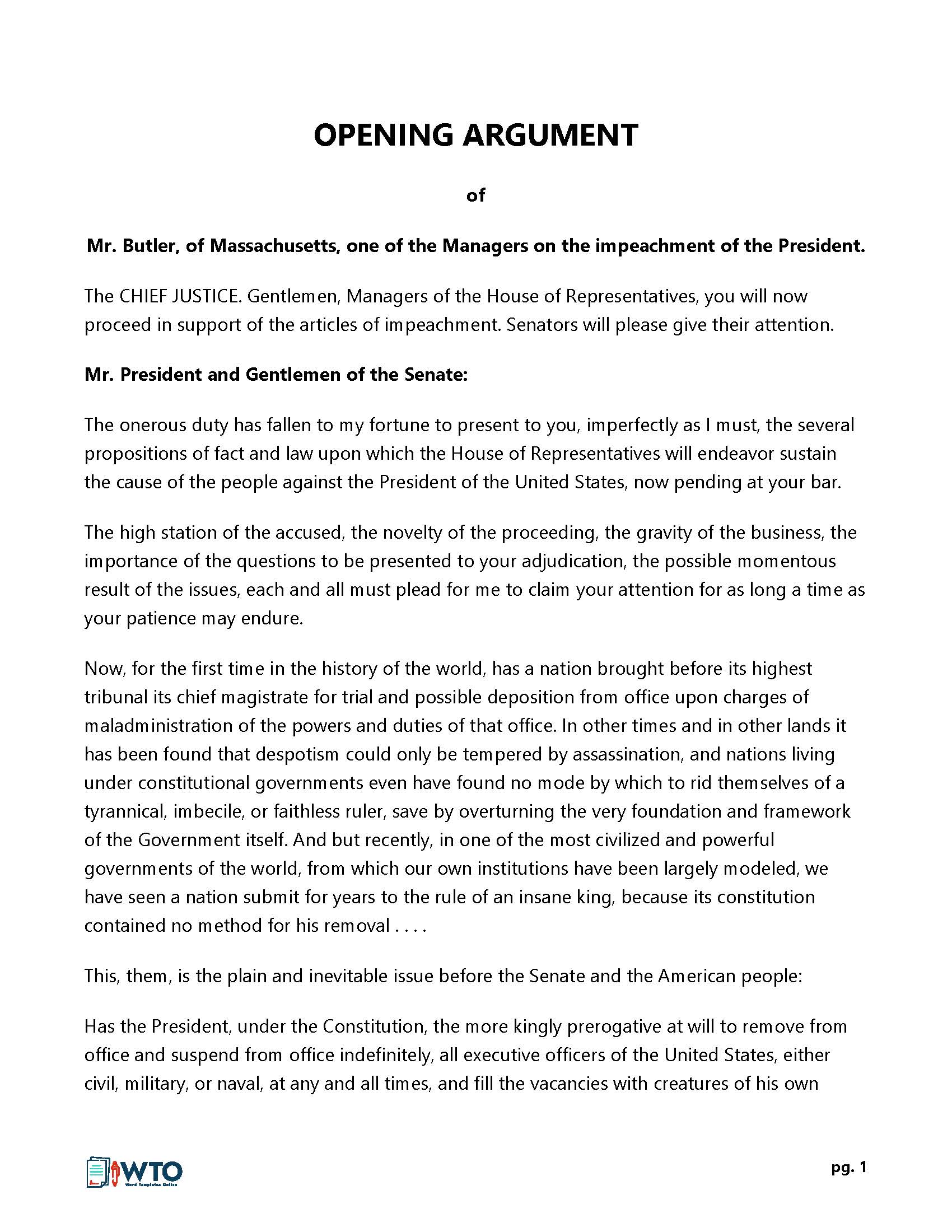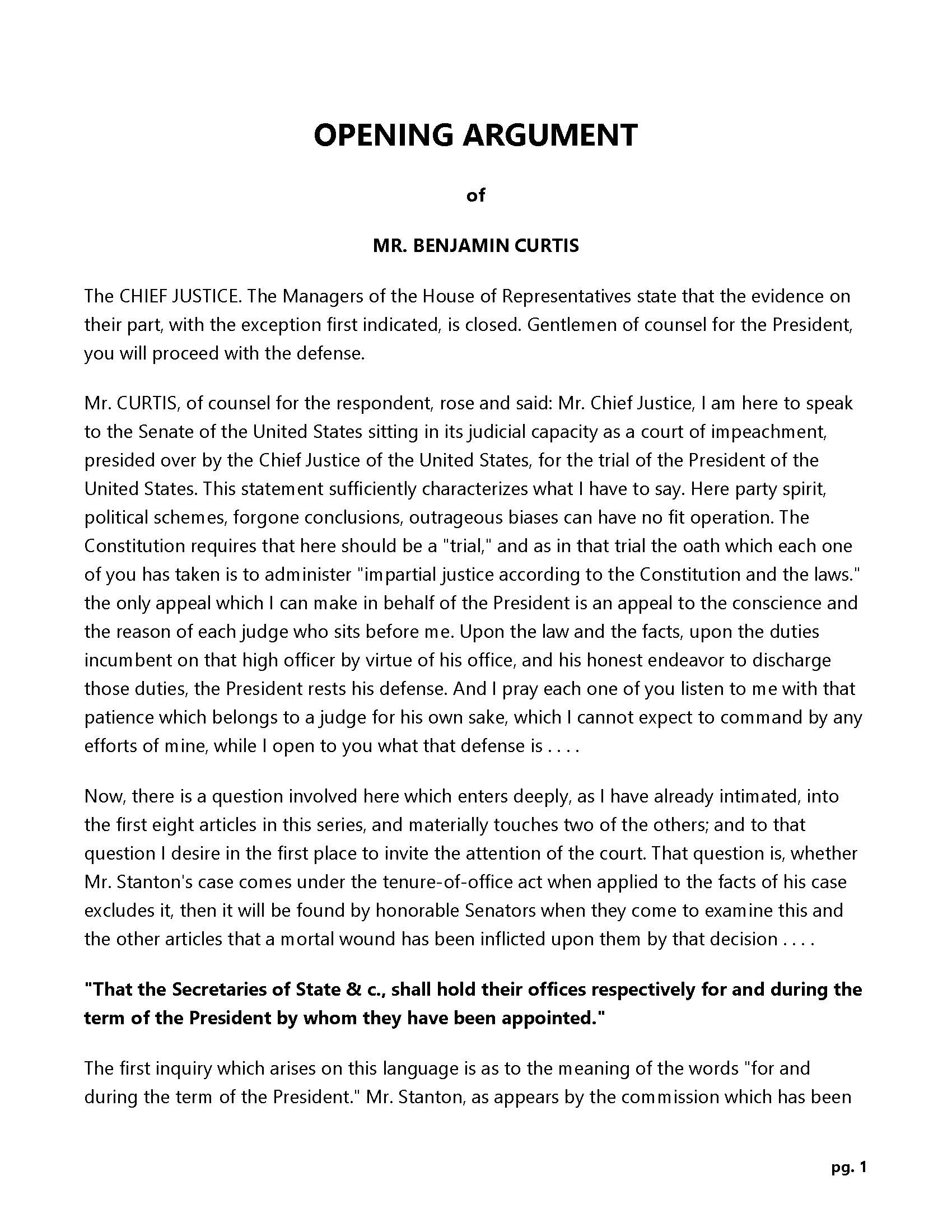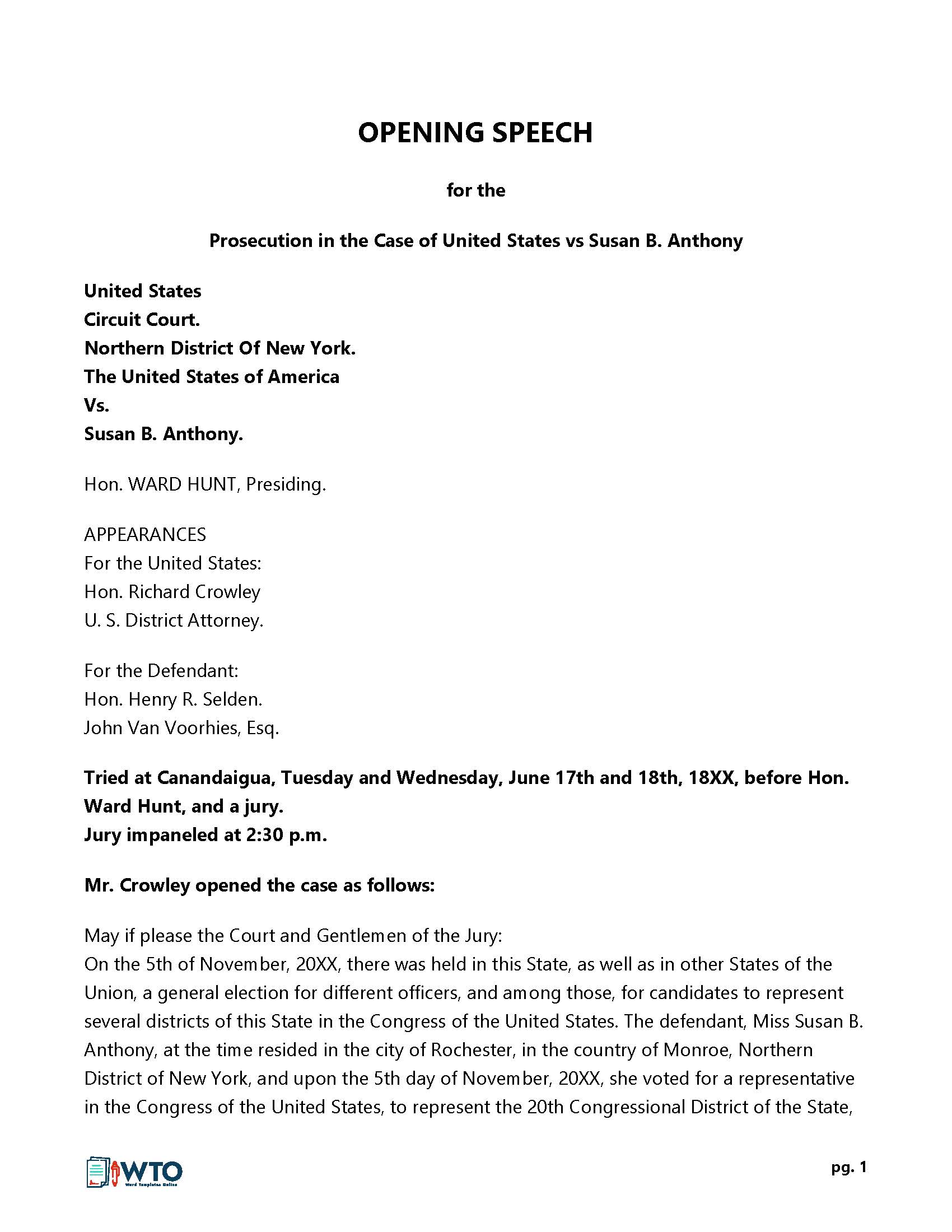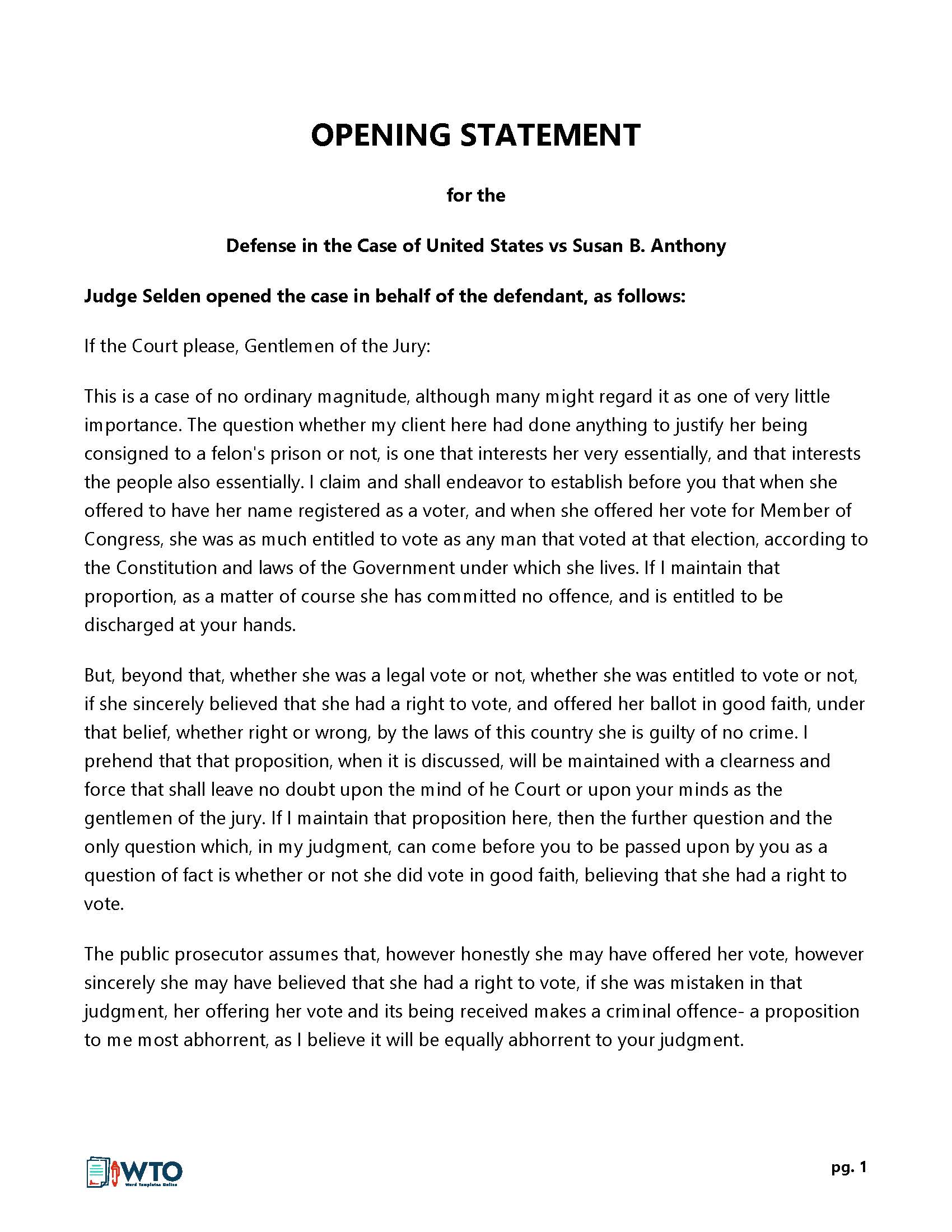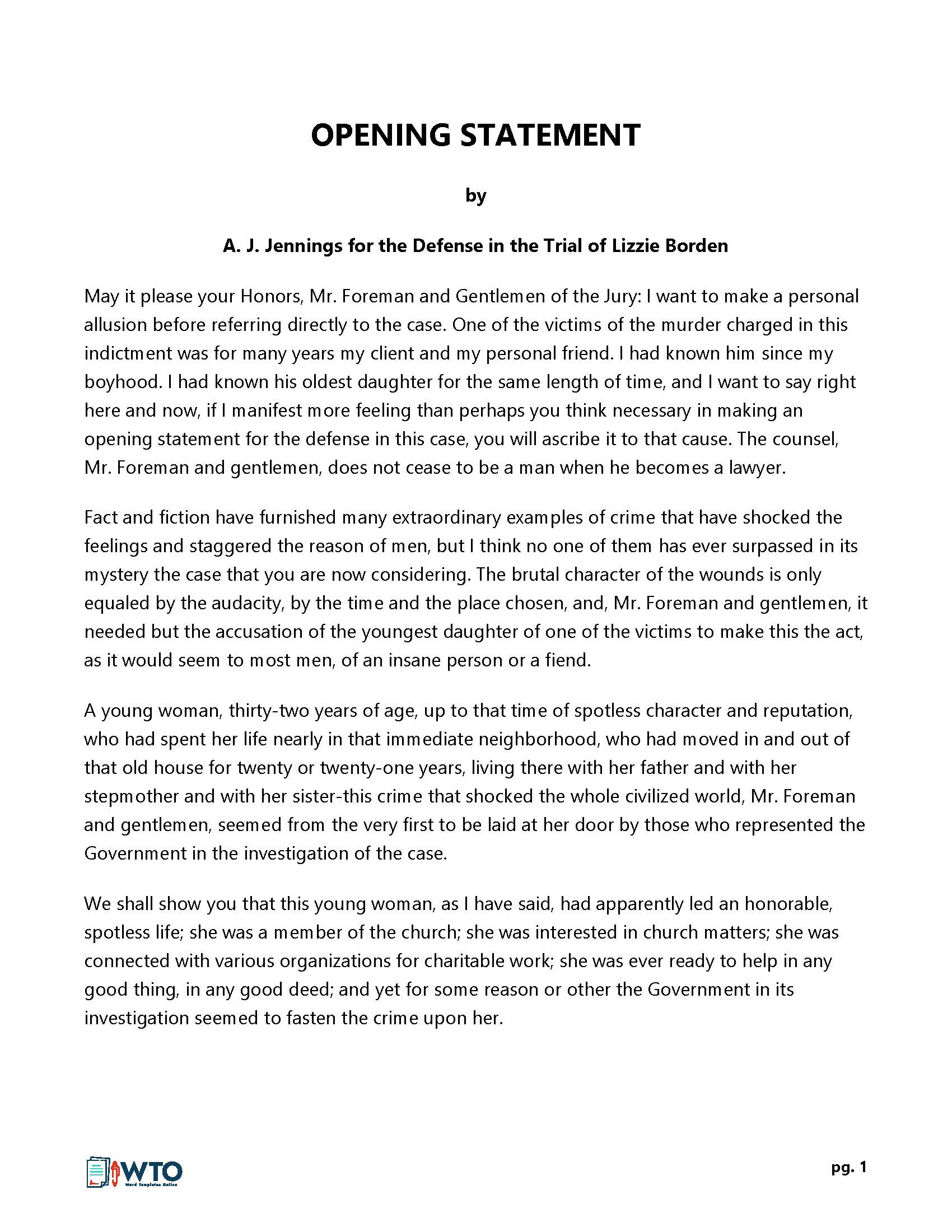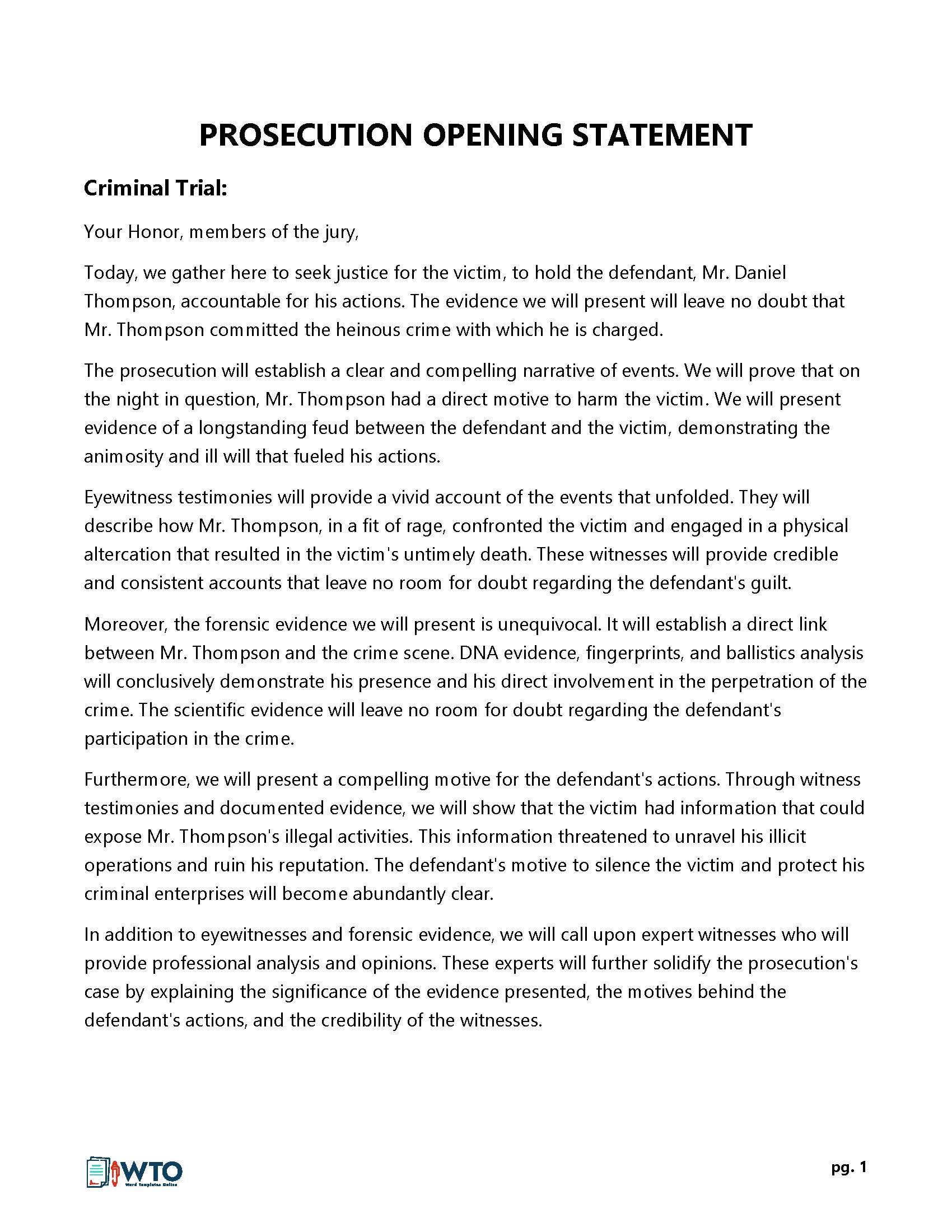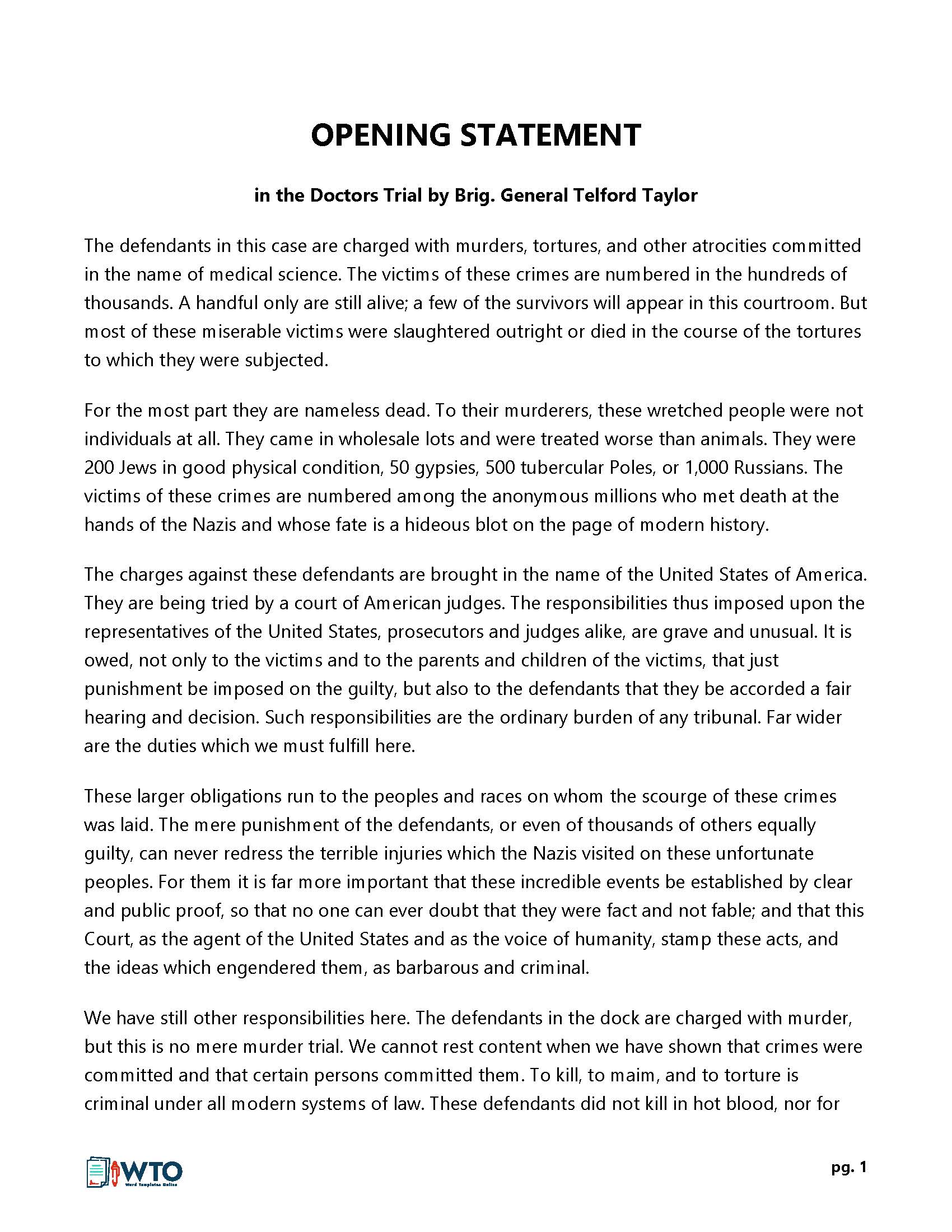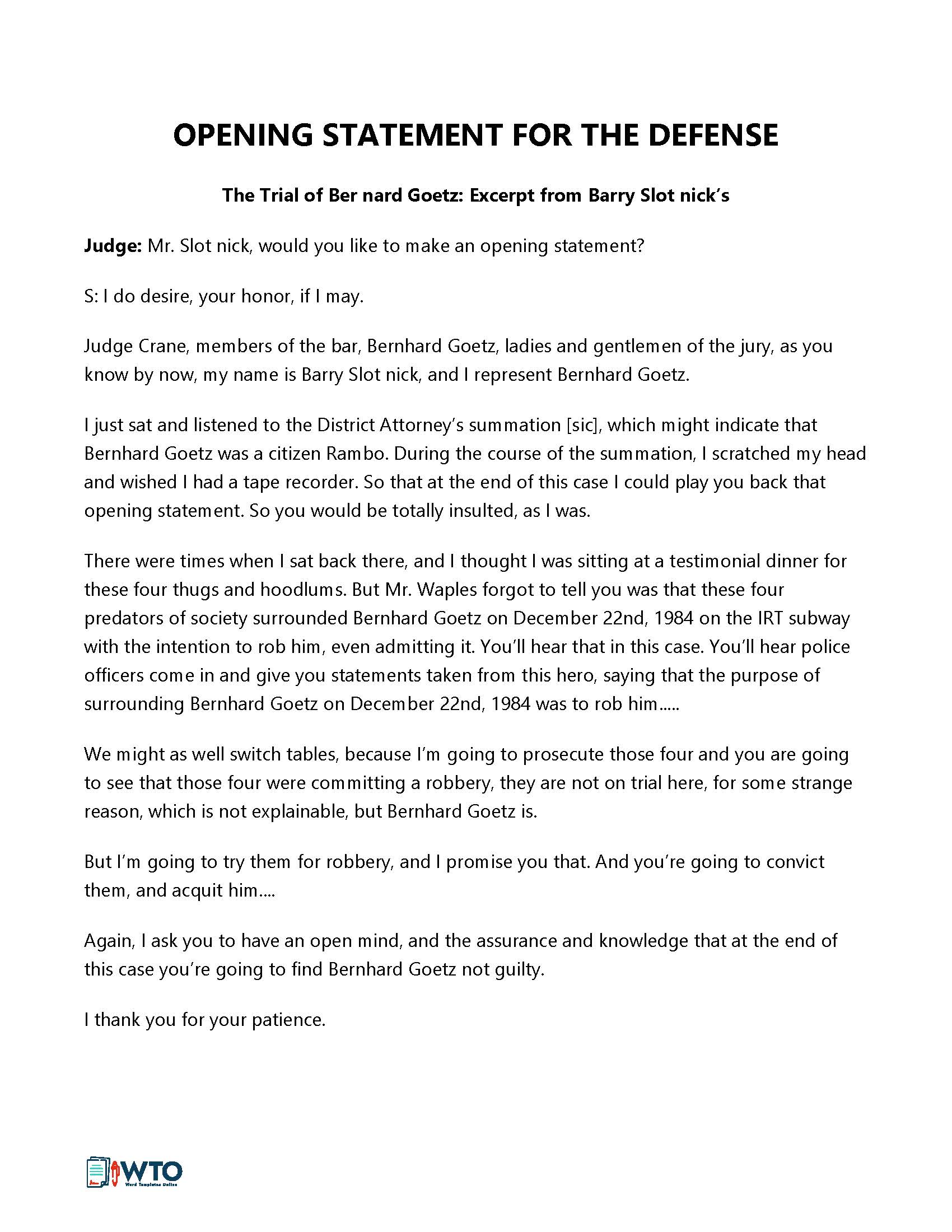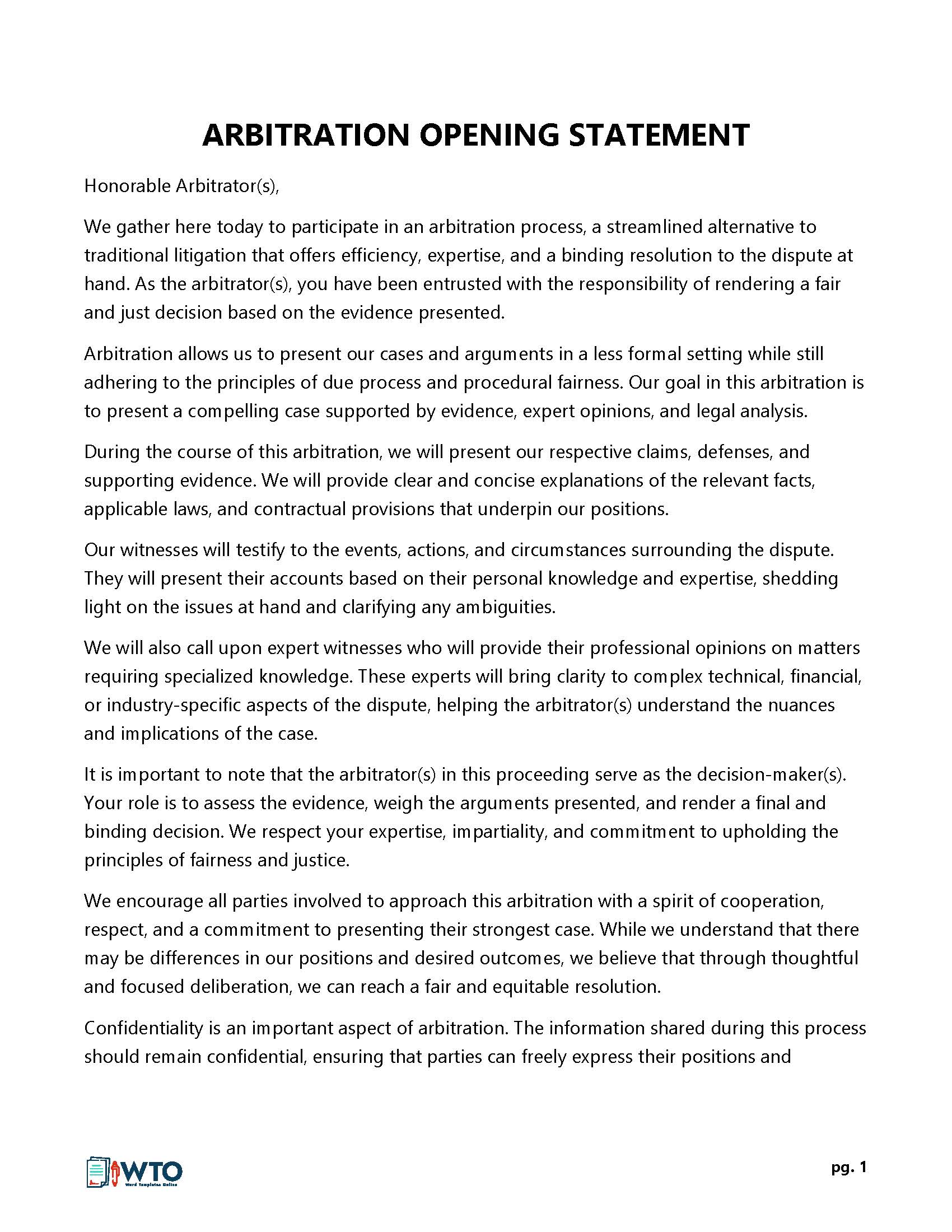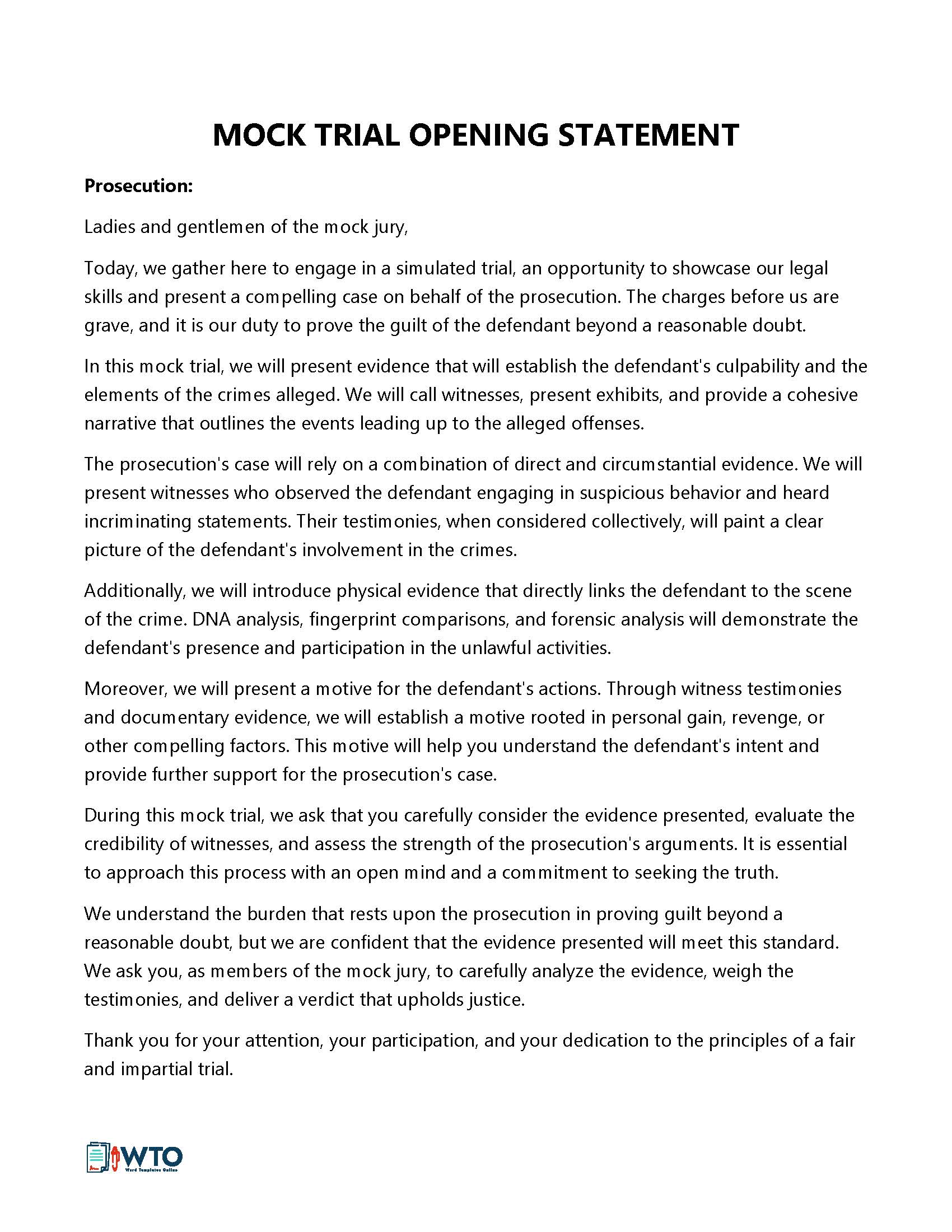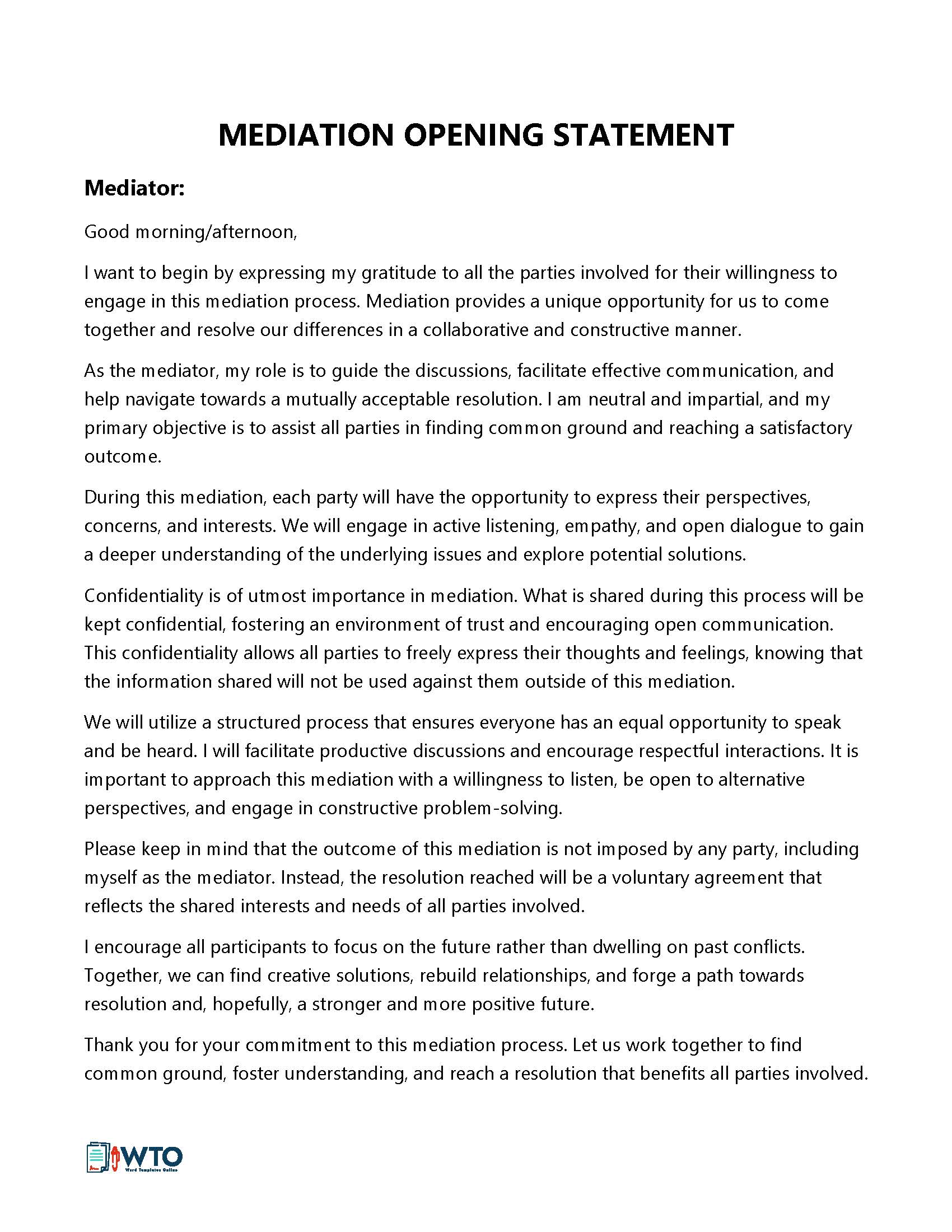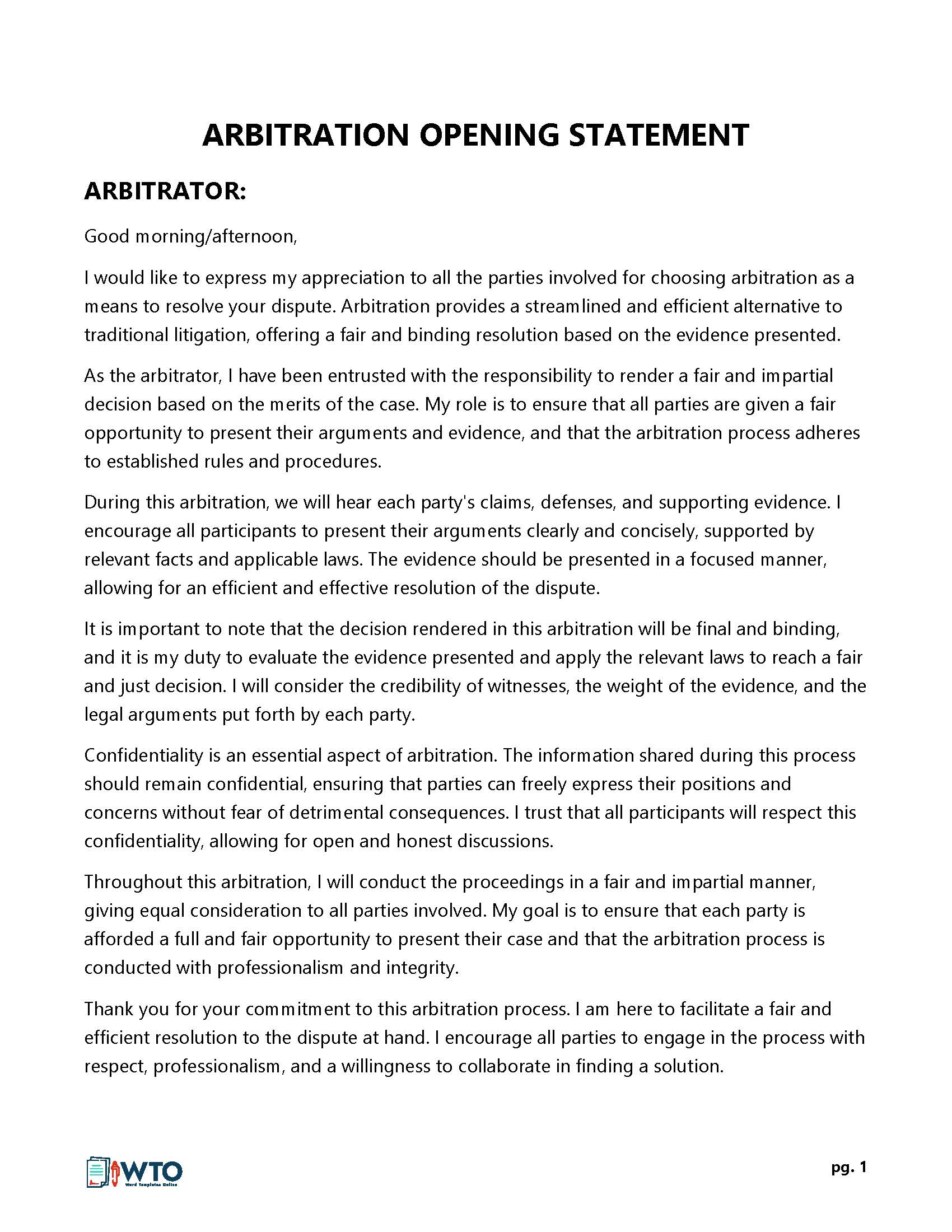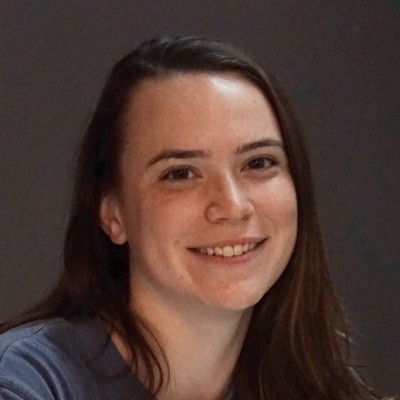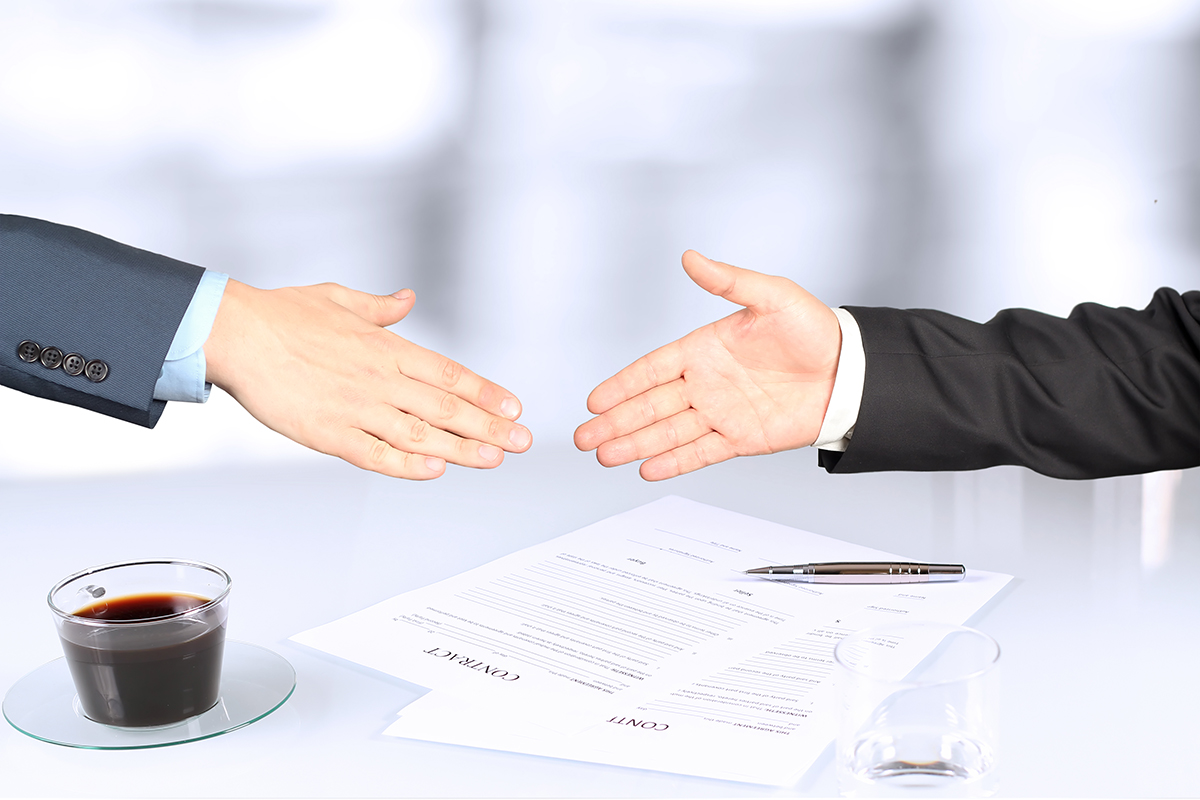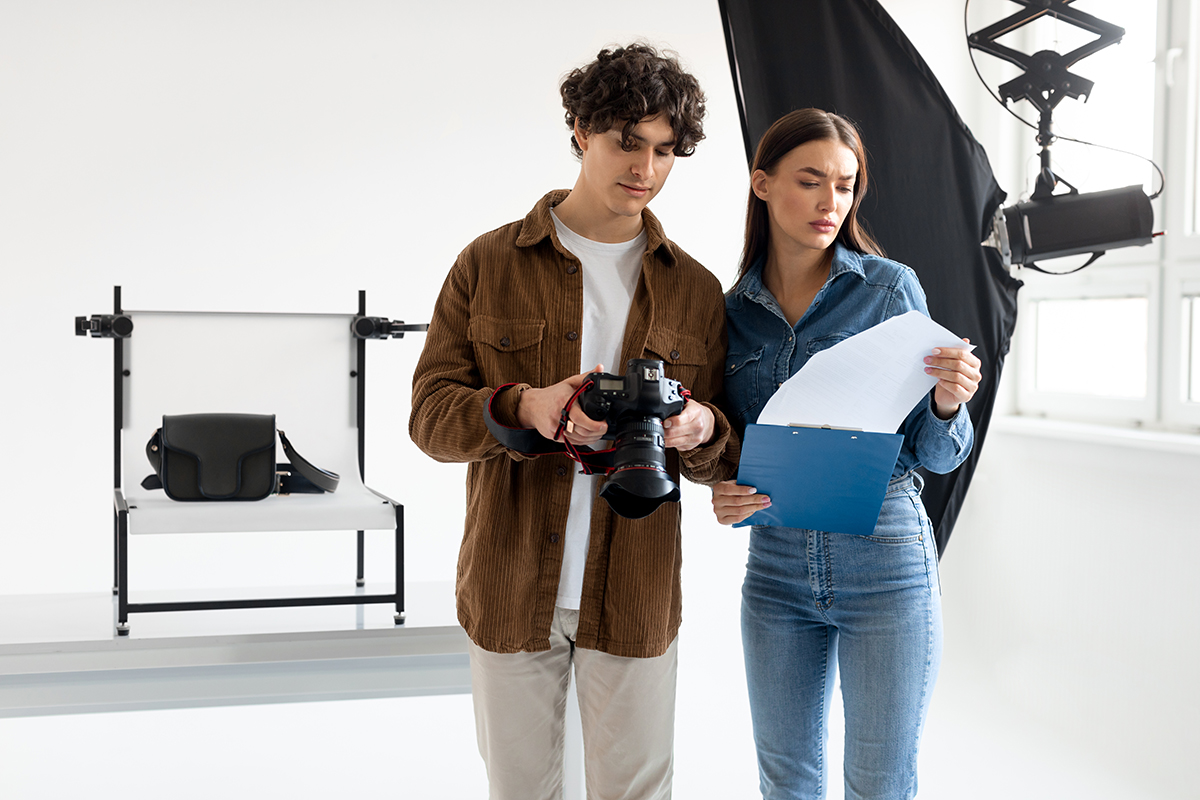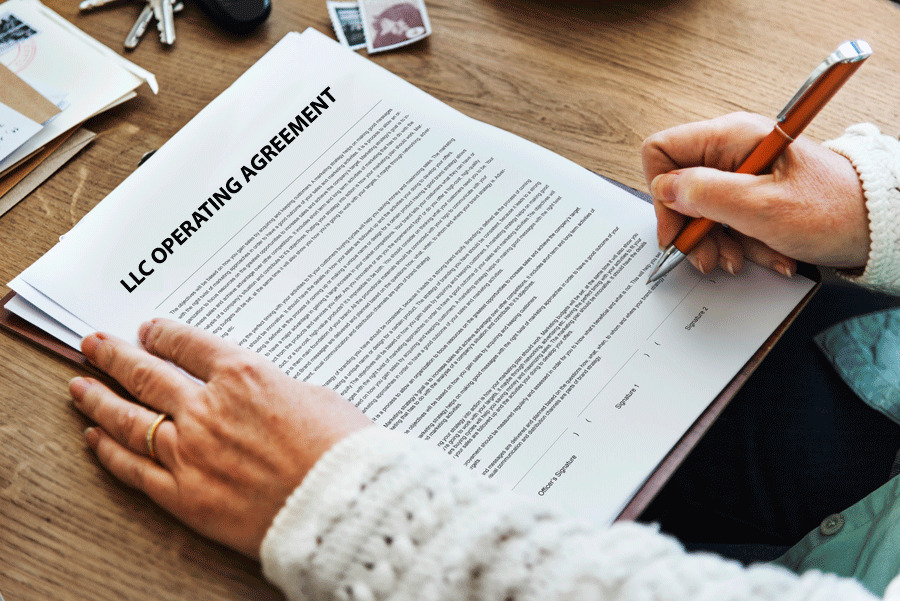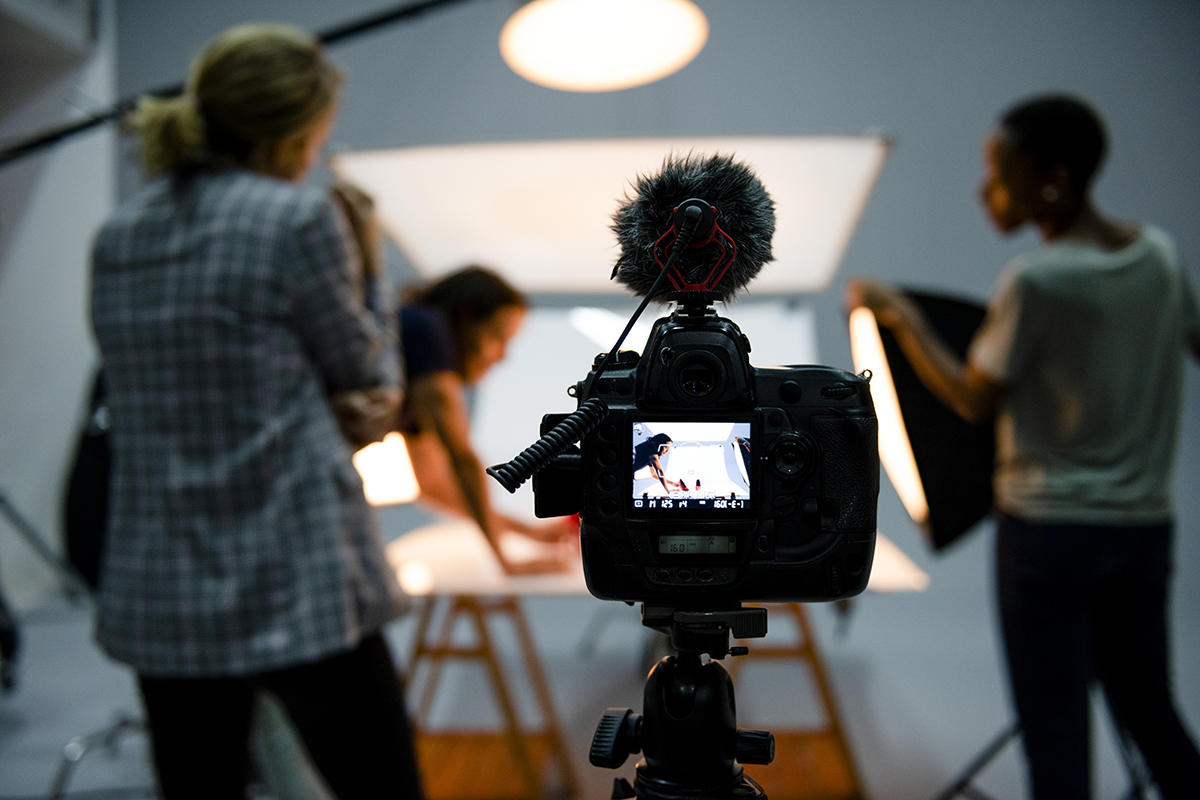In a courtroom setting, an attorney usually makes an opening statement that outlines the facts about the case to the presiding judge and jurors. It is also known by alternative terms, for example, debate or mini-essay. The plaintiff, defendant, or their representative can present it. The plaintiff (the party who files the case and bears the burden of proof) presents the statement first, followed by the defense team. It sets the stage for the trial and helps the attorneys frame their arguments and evidence coherently and compellingly. It should serve as a road map for the trial or fact-finding proceeding.
EXAMPLE
The state of Illinois indicted Mr. Karl Carter for fraud. The defendant was awarded a tender to supply 1,000 hospital beds to Illinois General Hospital by October 31, 2022. The conditions were that three-quarters of payments amounting to $100,000 were to be paid before delivery and the remaining balance after completion of the project. As per the agreed-upon conditions, a substantial portion of the payment, totaling $100,000, was to be made before the delivery of the beds, with the remaining balance to be paid upon project completion. The initial payment was duly made, fulfilling our obligations. However, it has come to light that the defendant has failed to fulfill his end of the agreement. Only 400 beds were supplied, citing increased production and transportation costs. To compound matters, the defendant has audaciously demanded additional payment, contrary to the initial agreement. Such a demand is not only unjust but also a violation of the principles upon which this contract was formed. I am Harvey Buck, representing the Illinois healthcare procurement committee. I request that the court intervene and hold the defendant responsible for civil charges against them.
This article discusses an opening statement, its importance, and the basic information that should be included before a lawyer presents it in court. It also deliberates on tips for developing a compelling one and provides examples for that.
Why is It Important in a Trial?
It holds great significance in legal proceedings, as it serves as the introduction to a case. Its primary purpose is to provide an overview of the case to the judge or jury, outlining the main arguments and evidence that will be presented. So, it is an integral component of any trial.
Below are reasons why it is important in legal proceedings:
Establish the context for the trial
The opening statement introduces the parties to the legal proceeding, including the plaintiff, the defendant, and their representatives. It also introduces the nature and type of the case—civil or criminal. It is also an opportunity to create a positive impression on the jurors.
Frames the issues
A well-crafted mini-essay should offer context to each party’s claims. This involves stating the issues at hand and providing an overview of factual evidence, background context, legal theories or arguments, and key details that will be presented to prove why their case is justified.
Establishes credibility
The introductory statement is meant to demonstrate the attorney’s credibility by showing that they understand the legal reasoning behind their case and can present a strong argument. It should reflect the qualifications and competencies of the attorney outlined in their resume. Also, it is meant to gain the jurors’ trust and confidence if it can clearly demonstrate the argument from the client’s perspective.
Provides a roadmap for the trial
Lawyers use it to communicate the evidence that will be used and the format in which it will be presented. It can name the witnesses that will be called to the stand and any supporting documents that will be referenced. This may include extensive research and interviews to identify credible witnesses and facts about the case. Once the fact-finders understand the framework to follow, they can collect information throughout the proceeding and make the best decisions for each case.
Increases persuasion
The debate should be adequately engaging to try and shape the jurors’ views and shift their stance to the best-case scenario for the client. An engaging statement has the following properties: clear, factual, narrative, and non-argumentative. The effectiveness of persuasion can significantly impact the overall trajectory of the case and contribute to a successful outcome for the client.
important
Lawyers may incorporate visual aids such as slides or images in it. According to research, visual aids increase jurors’ engagement and comprehension. Visual aids are efficient tools for persuading the jury and demonstrating how events occurred. However, the visual elements must be relevant to the case, simple, and easy to understand.
Free Templates
Opening Statement Vs. Closing Statement
An opening sentence offers the attorney an opportunity to mention the theme of the dispute and which evidence and testimonies will be presented in support of the client’s argument. It aims to make it easier for the judge or jury to comprehend the relevance of any evidence presented to the overall dispute.
Contrary to this, a closing statement allows counsel to present arguments on the merits of any evidence presented by both parties. It is given at the end of the trial to create a lasting impression. It may include hypothetical analogies, references to laws, key evidence, and comments on the witnesses’ credibility. Also, it can state the judgment that the counsel believes the court should make based on the evidence presented. Lastly, it can make a final appeal to the jury to favor the person being represented (the plaintiff or defendant).
Below are examples in different cases:
Criminal trial
Opening sentence example
Ladies and gentlemen of the jury, today we embark on a quest for truth and justice. The prosecution will present evidence that will demonstrate beyond a reasonable doubt that the defendant, Mr. John Roberts, committed the heinous crime he stands accused of. Through eyewitness testimonies, forensic analysis, and compelling evidence, we will reveal the sequence of events that led to the victim’s tragic death and the defendant’s direct involvement. You will hear from witnesses who saw the defendant at the scene of the crime, and experts who will shed light on the compelling physical evidence linking him to the murder. We ask you to keep an open mind and carefully evaluate the evidence presented, as we seek a verdict that reflects the truth and ensures justice for the victim and their grieving family.
Closing argument example
Members of the jury, you have heard the evidence, testimonies, and arguments presented throughout this trial. The facts have painted a clear and undeniable picture: the defendant, Mr. John Roberts, is guilty of the crime charged. The witnesses have bravely come forward and shared their accounts, their memories etched with the harrowing events they witnessed. The physical evidence, meticulously analyzed by experts, has left no room for doubt. The puzzle pieces fit together, revealing a chilling narrative of the defendant’s actions. It is now your solemn duty to deliver a verdict that upholds justice, that holds the defendant accountable for his choices and provides solace to the victim’s family. We urge you to render a verdict of guilty, for it is the only just outcome in light of the overwhelming evidence and the pursuit of truth.
Estate dispute case
Opening statement example
Your Honor, esteemed members of the court, we are here today to address a grave injustice concerning the denial of our client’s rightful claim to the estate left behind by her late husband. Our client, as the surviving spouse, should rightfully inherit the assets amassed by her husband during his lifetime. We will present compelling evidence, including a legally binding will that unequivocally designates our client as the sole beneficiary. Our aim is to seek justice, honor the wishes of the deceased, and ensure that our client receives the inheritance she is entitled to.
Closing sentence example
Your Honor, members of the court, we have reached a critical point in this trial where the fate of our client’s rightful claim to the estate hangs in the balance. We have presented clear and compelling evidence, including a legally binding will that unambiguously designates our client as the sole beneficiary. We must honor the intentions of the deceased and provide our client with the financial security and peace of mind she deserves. We implore you to carefully consider the evidence presented and render a just decision that upholds our client’s rightful claim to the estate.
Civil plaintiff trial
Opening statement example
Your Honor, esteemed members of the jury, today we bring before you a case that revolves around the fundamental principles of justice and accountability. Our client, [Plaintiff’s Name], has suffered significant harm and injustice at the hands of the defendant, [Defendant’s Name]. Through compelling evidence and expert testimonies, we will demonstrate that the defendant’s negligent actions have caused direct harm to our client, resulting in physical, emotional, and financial damages. We seek not only compensation for our client’s losses but also to ensure that the defendant is held accountable for their actions. We ask you to carefully consider the evidence presented and deliver a verdict that upholds the principles of justice and provides our clients with the restitution they deserve.
Closing sentence example
Your Honor, members of the jury, as we approach the conclusion of this trial, we urge you to reflect on the evidence presented and the significant harm our client has endured due to the defendant’s actions. Our client’s life has been irrevocably changed, and it is essential that justice is served. The evidence overwhelmingly supports our claim that the defendant’s negligence directly caused harm to our client, resulting in physical, emotional, and financial hardships. We implore you to stand on the side of justice, hold the defendant accountable for their actions, and award our client the compensation they deserve. By doing so, you will send a powerful message that negligent behavior will not go unchecked and the rights of innocent individuals will be protected under the law.
Child custody case
Opening sentence example
Your Honor, esteemed members of the court, today we come before you to address the critical issue of child custody in this case. Our client, [Client’s Name], firmly believes that the best interests of the child lie in their care. Through compelling evidence and testimonies, we will demonstrate that our client possesses the qualities, resources, and nurturing environment necessary to provide a stable and loving home for the child. We will present evidence that highlights the positive impact our client has had on the child’s well-being and development. It is our utmost priority to ensure the child’s safety, happiness, and overall welfare. We ask this honorable court to carefully consider the evidence and make a custody decision that serves the best interests of the child.
Closing argument example
Your Honor, members of the court, as we conclude this child custody case, we ask you to reflect upon the evidence presented and the well-being of the child at the center of this matter. Our client has consistently demonstrated their love, devotion, and commitment to providing a stable and nurturing environment for the child. The evidence overwhelmingly supports the notion that our client is the best fit to assume primary custody and make decisions in the child’s best interests. It is crucial to consider the child’s emotional and developmental needs and ensure their continued well-being. We trust in this court’s ability to discern the truth and make a custody decision that safeguards the child’s future and promotes their happiness and growth. We urge you to grant our client the custody rights they rightfully deserve.
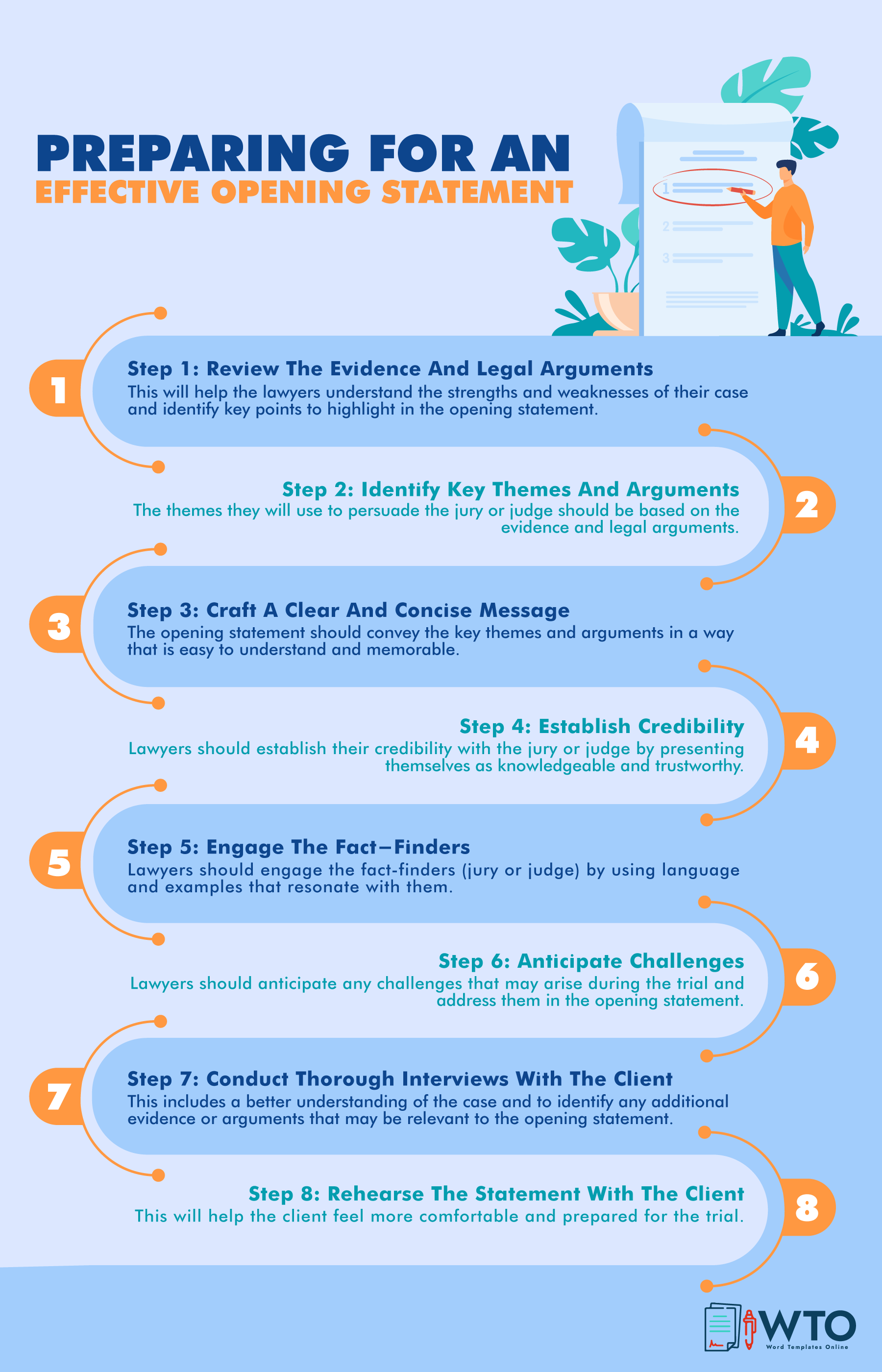
Anatomy of an Opening Statement: The Basic Information
An excellent initial sentence states what the attorney intends to prove, the framework to use, and events or facts supporting the client’s argument. It should be structured rationally to make it easy for the jurors to understand how the trial will be conducted. This means each mini-essay will vary from situation to situation.
However, each one has the following components:
Introduction
An appropriate introduction introduces the counsel, their client, the case theory, and the objectives of the trial. This segment is meant to build rapport with the jurors and inform them briefly about the case.
Hook
The attorney captures the audience’s attention by providing a compelling or intriguing statement related to the case. This can be a fact, a question, or a story that piques interest.
Explanation of the case
The introduction should also discuss the details of the dispute. The client’s perspective on the case should clearly and comprehensively emerge in this segment. By providing a clear and concise summary of the factual background, the attorney aims to ensure that the judge or jury has a solid understanding of the case from the outset. This overview acts as a foundation upon which the attorney will build their arguments and present supporting evidence to support their client’s position.
Explanation of how the evidence supports the client’s case
The attorney not only provides an overview of the case but also previews the evidence that will be presented to support their arguments. This may include witness testimonies, documents, expert opinions, or any other relevant evidence. By highlighting the evidence, the attorney aims to give the judge or jury a glimpse into the strength and credibility of their case. This helps to set expectations for the evidence that will be presented throughout the trial and allows the attorney to establish a persuasive narrative that supports the client’s position.
Witness identification
If witness statements are to be presented in court, it should indicate the number of witnesses and their profession. They may mention the key points they expect these witnesses to testify about, providing a glimpse into the evidence that will be presented. By highlighting the witnesses and their anticipated testimony, the attorney aims to establish credibility and build anticipation for the upcoming testimonies.
Conclusion
In the conclusion, the attorney summarizes the main points presented, reiterates the central theme of their case, and delivers a persuasive statement that sets the tone for the remainder of the trial. This concluding part aims to leave a lasting impression on the judge or jury by reinforcing the key arguments and emphasizing the strength of the attorney’s position.
By restating the central theme and making a compelling statement, the attorney seeks to create a sense of conviction and persuade the fact-finder to view the case from their perspective. The conclusion plays a crucial role in shaping the overall narrative and guiding the perception of the case moving forward.
Tips for Developing It Effectively
As illustrated earlier, a well-written mini-essay has a substantial impact on persuading a judge or jury. Below are tips on how to write an effective opening statement for your case:
- Prepare the debate to reflect the theme of the case so that it can appeal to the different qualities or personalities of the jurors. Also, having a theme enables you to develop a consistent and compelling message and organize evidence rationally. A good theme should grasp the jury’s attention and be memorable.
- The first sentence should be impactful. If you start strong, you will likely grab the jury’s attention and influence the rest of the trial.
- Information should be organized in an orderly and rational manner. This makes it easy for the jurors to follow the argument.
- Use the initial statement to demonstrate your knowledge of facts, accuracy, sincerity, and confidence in the evidence. These qualities will establish your credibility and persuade the jury.
- Be confident and likable; the storytelling techniques can persuade the jurors to favor your client. Other techniques include expressions and gestures. Such techniques help create an emotional connection with the audience.
- It should not be aggressive. It is primarily meant to be informative and persuasive to guide the court on the dispute between the parties and what each party will present to prove their case.
Examples
Opening statements will greatly vary depending on the party presenting them, its intended objectives, and the nature of the fact-finding proceeding.
Below are examples of these sentences:
Defense statement example
This is a debate presented by the defense team. It provides alternative explanations for the referenced occurrences, challenges witnesses’ credibility, and highlights weaknesses in the prosecution’s case. It aims to persuade jurors of the client’s innocence.
EXAMPLE
Mr. Harry Sendoff is wrongfully accused in this case. He bought the car months after the bank robbery he is accused of being part of. The vehicle was bought from Hybrid Motors under an as-is bill of sale to be presented. The title and vehicle registration ID will also be produced to show the date when the title was transferred. We hope that he will be acquitted with the indisputable evidence provided.
Prosecution statement example
A prosecution mini-essay indicates the elements of the crime and presents key evidence, witnesses, and legal grounds for the defendant’s guilt beyond a reasonable doubt. It aims to persuade the jury of the defendant’s wrongdoing and justification for prosecution.
EXAMPLE
This is a case of employee assault. Barry Miles has been an employee of Jerry Sanders for four years. CCTV footage shows multiple assaults by Mr. Sanders on multiple occasions. Mr. Miles feared reporting the crimes as he was threatened with being fired. We hope the court finds Mr. Sanders guilty of assault and blackmail and orders him to pay $100,000 in damages.
Mock trial statement example
A mock trial simulates or hypothesizes real events that led to litigation. So, its debate should provide a compelling narrative that accurately depicts the parties’ actions or events in the case.
EXAMPLE
This is a case of theft. Mrs. Sharleen Hides’ purse and phone were stolen by Mr. Barry Button through snatching, and he fled to the BigYellow Store. The phone was traced and found to be in Mr. Button’s possession. Multiple witnesses can attest to this fact and will be called to the stand. We hope the defendant can be found guilty and convicted, or pay a compensation of $5,000.
Mediation statement example
The statement for a mediation case typically begins by defining mediation as a voluntary and confidential process in which parties come together with the assistance of a neutral mediator to resolve their disputes. Mediation is based on open communication, active listening, and mutual understanding, aiming to facilitate dialogue and find mutually satisfactory solutions.
It provides an opportunity for the parties to express their perspectives, identify common ground, and explore creative options to resolve their differences without resorting to litigation. It emphasizes the importance of cooperation, respect, and the willingness to engage in productive discussions to achieve a mutually beneficial outcome.
EXAMPLE
Good morning/afternoon. My name is [Your Name], and I represent [Party Name]. With me is [Co-Counsel’s Name], and together, we will guide you through this mediation process. We are here today to resolve our dispute fairly and efficiently. Through constructive dialogue, we aim to find a mutually beneficial solution that addresses both parties’ concerns. Let us approach this process with an open mind, respectful communication, and a willingness to explore creative options. Our goal is to restore or enhance the relationship between the parties while reaching a fair resolution. Thank you.
Arbitration statement example
In an arbitration proceeding, which is a type of alternative dispute resolution, the opening statement acts as an introduction to the case and establishes the framework for the arguments and evidence that will be presented. It serves as an opportunity for the representatives of the parties to provide a concise overview of the dispute and its main issues, while also outlining their desired outcome or objectives.
Its purpose is to capture the arbitrator’s attention and ensure a clear understanding of the parties’ positions, ultimately guiding the subsequent proceedings toward a fair and impartial resolution.
EXAMPLE
Good morning/afternoon. My name is [Your Name], and I represent [Party Name]. With me is [Co-Counsel’s Name], and together, we will present our case before the arbitrator. We will diligently present evidence, testimonies, and legal arguments to support our position. Our commitment is to fairness, integrity, and professionalism throughout this process. We trust the arbitrator’s expertise in making a reasoned decision based on the facts and legal principles presented. Thank you.
Frequently Asked Questions
The length of the mini-essay will depend on the complexity of the case. Additionally, in some jurisdictions, there are restrictions on its length, while in others, the judge has discretion in determining the appropriate length. However, most statements will last between 10-45 minutes.
Attorneys are restricted to providing facts they intend to prove and admissible evidence only, rather than making legal arguments or drawing conclusions. Lawyers must also respect the presumption of innocence, particularly in criminal cases, and avoid making statements that assume the guilt of the defendant. It is important to avoid using language that could unduly influence the jury. Moreover, attorneys should only discuss admissible evidence that has been properly introduced in court, following evidentiary rules. Familiarity with the specific rules and guidelines of the jurisdiction is essential to ensuring compliance with the limitations imposed on opening statements.
Attorneys should focus on presenting their own case rather than attacking or criticizing the opposing party. The focus should be on presenting their own evidence and arguments.
